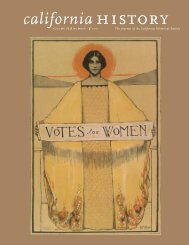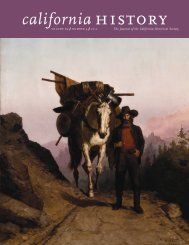Volume 90, Number 1 - California Historical Society
Volume 90, Number 1 - California Historical Society
Volume 90, Number 1 - California Historical Society
Create successful ePaper yourself
Turn your PDF publications into a flip-book with our unique Google optimized e-Paper software.
eviews<br />
of wives and small children, wageworking<br />
Indians, and high school students.<br />
In his chapter on the “Beeters,”<br />
Wyman explains how the early corporate<br />
domination of beets in Nebraska<br />
led to especially grueling labor conditions,<br />
where sugar entrepreneurs<br />
preferred families for their stability,<br />
less drunkenness, and, most crucially,<br />
more hands. The book depicts the<br />
use of convict labor, including several<br />
locked up on vagrancy charges, and<br />
the yearly migration to the Willamette<br />
of Native Americans, who picked hops<br />
for wages, moving between their traditional<br />
homes and capitalist society.<br />
The single itinerant hobo is but one of<br />
many characters in Wyman’s work.<br />
Ethnic diversity also plays large in<br />
Wyman’s history. The book illustrates<br />
the striking differences between organized<br />
Japanese work gangs, doubly<br />
discriminated Mexican laborers, and<br />
German-Russian migrant families<br />
seeking the American dream through<br />
acquiring their own property. It also<br />
brings to light the ethnic alliances<br />
forged through harvest labor, such as<br />
the pan-Indianism formed through<br />
tribal migrations and the successful<br />
organizing by the International Workers<br />
of the World of a seemingly impossible<br />
ethnic assortment. Although this<br />
is a scholarly text, Wyman connects<br />
meticulously curated statistics, archival<br />
news reports, and policy memos with<br />
the personal experiences of the workers,<br />
rendering sympathetic portraits<br />
72 <strong>California</strong> History • volume <strong>90</strong> number 1 2012<br />
of his subjects and lively passages that<br />
move the work forward with verve.<br />
Art Hazelwood’s Hoboes to Street<br />
People: Artists’ Responses to Homelessness<br />
from the New Deal to the Present picks<br />
up where Wyman leaves off, in the<br />
Great Depression, and presents powerful<br />
works of art aimed at social change.<br />
The beautiful publication is a product<br />
of the touring exhibition that first<br />
opened in San Francisco in 2009 and<br />
features nearly sixty works of visual art<br />
engaged with issues of homelessness.<br />
But this is no mere exhibition catalog.<br />
Hazelwood’s book traces the artworks<br />
through historical shifts in government<br />
policy, from the New Deal to Welfare<br />
Reform, and examines artists’ shifting<br />
relationship to their subjects and to the<br />
state, first as government WPA artists<br />
and photographers and later as activist<br />
artists relentlessly critical of the state.<br />
As Hazelwood himself is a member of<br />
the former camp, the book reads as a<br />
manifesto for artists to join together to<br />
inspire the public to act.<br />
The book features works by wellknown<br />
artists such as Dorothea Lange,<br />
Rockwell Kent, and Anton Refregier,<br />
but also resurrects older political artists<br />
who have largely been forgotten,<br />
including Leon Carlin and Giacomo<br />
Patri. Contemporary artists include a<br />
host of <strong>California</strong>ns, among them Jose<br />
Sances, Sandow Birk, and the formerly<br />
homeless Jane “in vain” Winkelman.<br />
The book brings together the works<br />
one usually finds on gallery walls and<br />
in an array of popular media aimed<br />
at the public conscience: screen-print<br />
posters, cover art of homeless broadsheets,<br />
and graphic novels.<br />
Although Wyman misses the opportunity<br />
to connect the history of the<br />
hoboes to migrants of today, dialogues<br />
between contemporary and past perceptions,<br />
portrayals, and policies of<br />
homelessness are at the center of<br />
Hazelwood’s survey. The book opens<br />
with two photographs: Dorothea<br />
Lange’s Mother and Two Children on<br />
the Road to Tule Lake, made in 1939,<br />
and David Bacon’s photograph of an<br />
indigenous woman and child, part of<br />
a group of farmworkers from Oaxaca,<br />
made nearly seven decades later. It<br />
is striking how little has changed<br />
when confronting the human pathos<br />
expressed in each portrait depicting<br />
mothers attempting to maintain their<br />
families amidst economic catastrophe.<br />
Yet, Hazelwood notes important distinctions:<br />
the globalizing forces that<br />
have reshaped agricultural economies<br />
since Lange’s era, the rollback of New<br />
Deal reforms, and the growing public<br />
perception that economic insecurity is<br />
considered a sign not of greed, but of<br />
a properly “flexible” workforce. In this<br />
new era of precarious labor and draconian<br />
anti-immigration policy, these two<br />
books offer historical perspectives that<br />
not only explain how we got here, but<br />
also provide the critical lenses necessary<br />
to imagine progressive futures.









